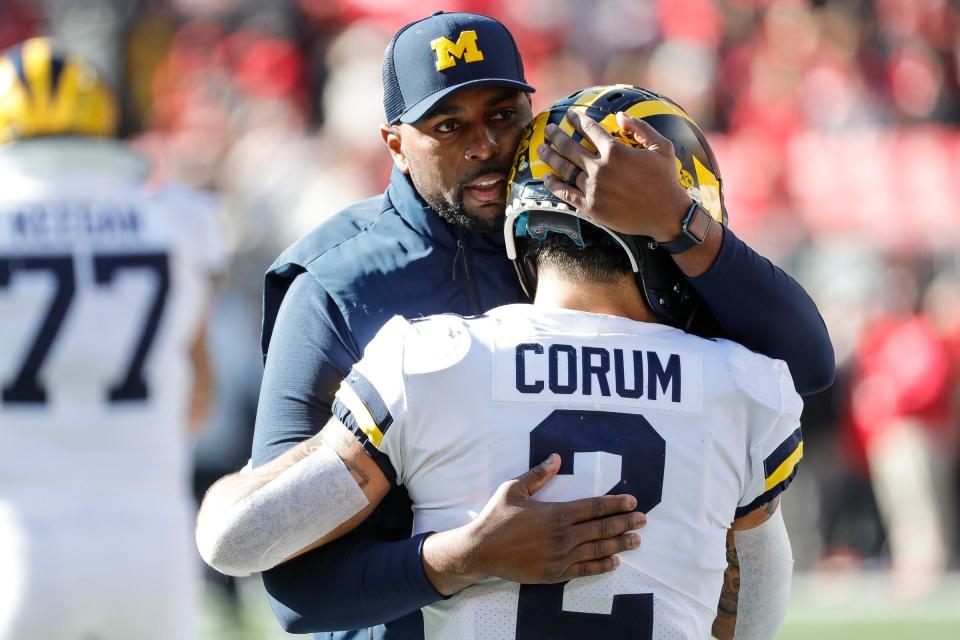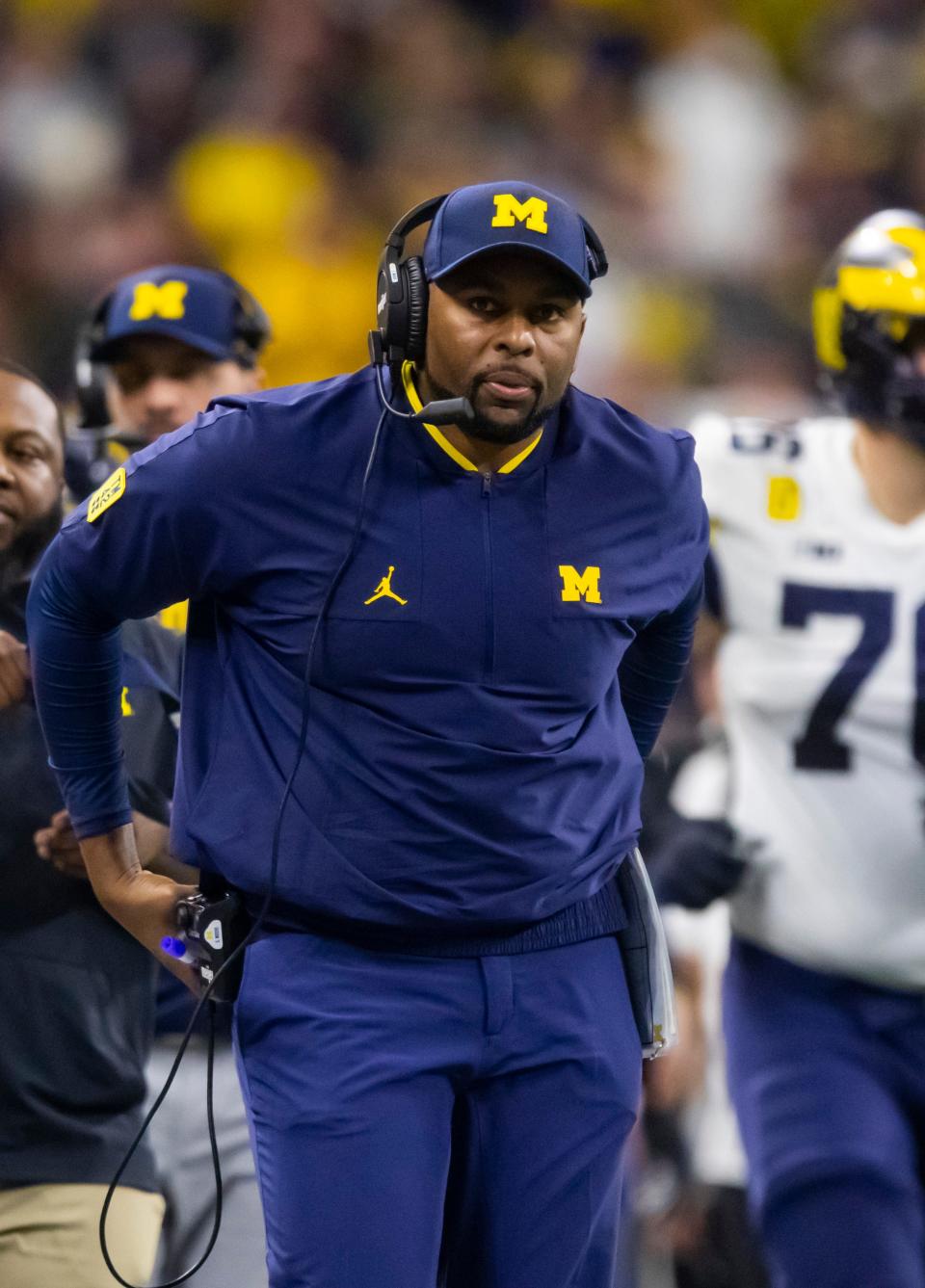How one coach's growing influence has corresponded with Michigan football's rebirth
SCOTTSDALE, Ariz. — Almost 48 hours after Michigan football conquered Ohio State in Columbus, the rapture had yet to subside. Jim Harbaugh was feeling himself, still intoxicated by the euphoria that surfaced after the Wolverines demolished their rival and completed a perfect regular season.
As he crowed about this, that and the other during a news conference that lasted far longer than usual, he set aside a few moments to deliver a full-throated endorsement of co-offensive coordinator Sherrone Moore.
“Beyond ready,” Harbaugh said, “to be a head coach.”
Harbaugh’s emphatic declaration still reverberated a month later, echoing 2,000 miles away in the Arizona desert, where Moore was asked about the possibility of one day running his own program. The modest architect of the nation’s best offensive line quickly demurred.
“When the time comes, the time comes,” Moore told reporters. “But I’m in no rush to leave this place, this great university, these students and coach Harbaugh.”
PRACTICE OBSERVATIONS:DE Mike Morris in, WR Andrel Anthony out

After all, Moore and Harbaugh have formed a successful partnership that has led to the most prosperous period of Michigan football this century. In the past two seasons, they have helped shape the philosophy that has lifted the program to 25 victories in its last 27 games, a pair of Big Ten championships and consecutive College Football Playoff appearances.
The Wolverines’ rise from a malfunctioning team to an emerging powerhouse in a span of 25 months has corresponded with Moore’s influence growing inside the walls of Schembechler Hall, where he and Matt Weiss devise the offensive strategy as the two play-callers. It seems no coincidence then that u-m’s offense runs through its sturdy blocking front and deep cast of tight ends, the two position groups Moore has presided over since joining Harbaugh’s staff in 2018.
“Historically, when Jim’s been successful, which is almost all the time, he’s had this style of football,” Weiss said. “He has physical teams. He has tough teams. That’s kind of his calling card as head coach. And Sherrone fits that mold perfectly. It’s really, really a great match.”
'MORE AS A BUSINESS TRIP':Michigan a year wiser with College Football Playoff experience
But the strength of that union didn’t become obvious to outsiders until last year, when the Wolverines began the restoration of a program that nosedived to a 2-4 record in 2020. Moore called that miserable season “probably the worst” the university has seen. Some players attributed the rot to “selfish” teammates. Others pointed to a bankrupt culture that polluted the environment around them. But in a more tangible sense, Michigan helped seal its fate by moving away from its true identity.
Although Josh Gattis, Moore’s predecessor at offensive coordinator, tried to speak “Speed in Space” into existence, it never took root within the parameters of a playbook that still had Harbaugh’s fingerprints on it. The result was a hodgepodge of competing ideas, and Michigan suffered on the field. The Wolverines controlled the ball 25:37 per game, the fifth-shortest average time in the nation. They also ran it at a lower frequency than 121 teams in the Football Bowl Subdivision. At a surface level, the Wolverines simply looked different while operating out of three-receiver sets 63% of the time, according to SportsSource Analytics.
To that point, the tight end was marginalized under Gattis’ direction. With Moore and Weiss at the helm, it has been featured once again.
Even after former Wolverine Erick All was lost for the season in Week 3, multiple tight ends have been deployed on more than half of Michigan’s plays. These hybrid players have helped turn Harbaugh’s rugged bunch into the most efficient ground-and-pound team in the country, as evidenced by Michigan’s standing as the only program from a major conference that ranks in the top five in both rushing and time of possession.
“We pushed ourselves to change the atmosphere of what we are and who we are as Michigan football,” Moore said.
Moore, in many ways, was a catalyst for the transformation.
As part of a staff overhaul during the 2021 offseason, Harbaugh cut ties with offensive line coach Ed Warinner and reassigned Moore as his replacement.
It was a risky, rather unorthodox move because Moore, the tight ends coach, had never been tasked with that role at Michigan or any of his previous stops. But as a former guard at Oklahoma under Bob Stoops, he had a sense of what was needed. Most importantly, he knew what it meant to play with grit and relentlessness.
'THE BEST ... PLAYING THE BEST':Michigan arrives in Phoenix for College Football Playoff

“We were always pretty emphatic that hard work will beat talent when talent doesn’t work hard,” Stoops told the Free Press. “Nobody was going to outwork us … I think sometimes a few schemes here and there are a little overrated. It’s who can execute the best and be the toughest the longest.”
That was seen on the field in Columbus four weeks ago. When the game hung in the balance, Michigan showed its might. The offensive line, directed by Moore, bullied the Buckeyes before breaking them, opening the holes through which Donovan Edwards sprinted during a pair of touchdown runs that sealed the victory.
The stunning sequence offered further proof U-M is a reflection of a man who has gained Harbaugh’s ultimate trust and imprimatur. Why is Harbaugh so enamored with Moore? Look closer, and the answer becomes obvious. He views Moore as a dependable consigliere and future head coach because he is the mirrored image of Harbaugh himself.
“What we do,” Moore said, “is coach’s identity.”
Then he paused for a beat.
“And it’s really my identity as well.”
Contact Rainer Sabin: rsabin@freepress.com. Follow him on Twitter @RainerSabin.
This article originally appeared on Detroit Free Press: How Sherrone Moore helped Michigan football return to its roots

